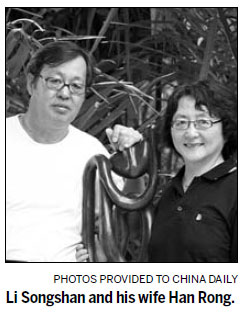Long love affair with African art
Updated: 2014-03-30 07:37
By Liu Lu (China Daily)
|
|||||||||||
A Beijing couple are on a mission to make Chinese more familiar with the brilliant Makonde woodcarvings. Liu Lu reports.
In Songzhuang, Beijing's biggest artist community in the eastern suburbs of the city, there is a special art center that stands out from the other galleries because of its exotic artworks.
Bright blue walls surround the center. After walking past a construction site, the view suddenly brightens, with numerous exquisite woodcarvings scattered around a large space. Their colors, lines and contours reflect a faint glow from the lamplight, creating an artistic world full of mystery.
The owners of the center are a retired Chinese couple, 72-year-old Li Songshan and his 69-year-old wife Han Rong. Building such a gallery was the realization of a long-held dream for the two elderly people.
With 13 buildings covering 1,000 square meters, the center, which is called African Tribe, has hundreds of Makonde carvings the couple have brought back from Africa over the past 30 years. It will be completed and open to the public in May, and will be the first privately owned non-profit organization in China dedicated to promoting African culture.
"Our purpose in building this African culture center is to promote African culture and art in China, and to build a platform for China-Africa cultural exchanges," Li says.
"As far as I know, in recent decades, Chinese people have expanded their activities from trade and investment to cultural exchanges in more and more African countries, helping African people gradually learn more about China and its people.
"But the exchange is not equal. In contrast, opportunities for Chinese people to learn about Africa are relatively rare. People in China don't know much about African culture and art. I hope we can do something to correct this by opening this African cultural center in Beijing, China's culture capital."
The couple says they started working in Africa in the early 1970s and became obsessed with Makonde sculptures, as they thought those imaginative carvings were endowed with a sense of optimism that only African people possess.
"Each work is unique," Han says. "There are no two the same, and it's impossible to copy them. Makonde art is the most representative output from Africa in the art scene."
She says Makonde carving is probably the best-known art produced in Tanzania, where the Makonde people create delicate carvings in African ebony. The local craftsmen use their tribal myths and stories as inspiration for the pieces, but the carvings also feature a modern response to contemporary life.
"Not many people have heard of Makonde art, but people may look at it with new eyes once they learn that many of the great modern artists in Europe saw it as a new art language. Even Pablo Picasso drew inspiration from it. Those sculptures have greatly influenced international modern art."
Han says, with their exaggerated appearance and sometimes grotesque postures, the sculptures embody the fantasies of artists, and each one is endowed by the artists with different meanings.
"Some say it is hard to understand them, but I think art is about feeling, inspiration and imagination, rather than obscure theories. Every artwork is worthy of appreciation."
The establishment of African Tribe has attracted attention from high-level officials in both China and Africa.
Bernard Membe, Tanzania's minister of foreign affairs and international cooperation, attended the center's foundation-laying ceremony in July, 2012. He spoke highly of Li and Han's contribution to introducing African art, especially Tanzanian art, to Beijing and China, and said they are "the real Tanzanian ambassadors to China".
The complex has already received groups of African guests from many countries, most of them officials or diplomats.

"My wife and I feel very happy every time we hear visitors say they felt at home at the center," Li says.
African Tribe is composed of four parts: the African Art Experiencing and Exhibition Hall, African Artist Workshop, African craft shops run by Africans, and the African Makonde Art Institute.
In addition to art appreciation, Li hopes he can cultivate interest among more Chinese people in this particular art form through organizing workshops and seminars, and also expand Chinese people's knowledge of Africa to wider areas, such as politics and the economy.
"We hope through what we have done, we can make African people feel that their Chinese friends respect and appreciate their arts and culture, and it may help them boost self-confidence in their cultural legacy," Li says. "Our ultimate goal is to promote China-Africa friendship."
Prior to the establishment of African Tribe, Li and Han had donated more than 12,000 exquisite African woodcarvings and paintings they had collected from Tanzania, Malawi, Zambia and other southeastern African countries to the Changchun municipal government. Then a Songshan Hanrong African Art Collection Museum was built to display the collection, allowing local people a close look at these masterpieces.
The museum is the first of its kind to specialize in foreign art and the collection was the largest donation of foreign art since the founding of the People's Republic of China in 1949. Those artworks mean that China now has the largest collection of contemporary Makonde sculptures outside Tanzania.
"To put these works in a museum allows more people to learn about African culture and art," Li says, adding that the public museum can also better maintain the collection.
Li says Makonde carving is an important part of the world's art treasures and, by becoming familiar with it, Chinese artists will be able to use it as inspiration for their own creative endeavors.
Contact the writer at liulu@chinadaily.com.cn.
|
Makonde carving uses African ebony and draws inspirations from Tanzanian tribal myths and stories. It features of a modern response to contemporary life. |
(China Daily 03/30/2014 page5)
Today's Top News
Putin calls Obama to talk Ukraine
Chinese plane spots 3 objects
Xi defends national defense buildup
Turkey labels YouTube leak a 'plot'
DPRK lashes out at ROK 'gangsters'
World's longest-held death row inmate freed
China, Germany to build yuan center
Xi urges inter-civilization exchange, mutual learning
Hot Topics
Lunar probe , China growth forecasts, Emission rules get tougher, China seen through 'colored lens', International board,
Editor's Picks

|

|

|

|

|

|






